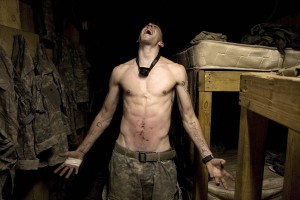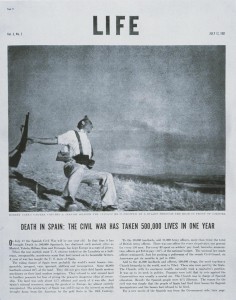I do find Capa’s arguments to be convincing. He is risking his life to obtain such photographs in many situations so why lie about the uniqueness and the stories behind each photo. Being a war photographer I don’t really see much time for Capa to stage his photographs. I contemplate they are more along the lines of in the moment. Because you can be in the right place at the right time and truly accidentally find your money shot or award shot. Although some of his photographs do leave room for speculation. Such as the photograph of his soldier that he captured in the moment when he was shot and just about to fall to the ground. There is no blood, bullets or other soldiers in this shot and the almost graceful fall of the soldier appears to be just to perfect. If this was a battle shot and this man had been shot why is there no one else on the field and why isn’t he in uniform? There was the statement that Capa said that they were running military drills and this man was accidentally shot during the procedures. Although this does seem like a valid explanation of the story behind his photograph we may never know. However I don’t think it matters if a photograph is staged or not because it can still be as impactful. Such as the monumental photograph of the united states flag being hoisted up while on the battle field this photograph looks somewhere in between staged and authentic but when he gives his explanation of how he just so happened to turn around and snap the picture and it turned out to be a success I believe that is true. Multiple times I have just snapped shots and surprisingly they were great. Tons of photographs today are staged in modern day however they still hold their points and get the message across to the public. I don’t think authenticity adds or subtracts from the work and efforts a photographer putts into his shots.
Contact Information
Professor Sandra Cheng
Office: Namm 602B
Office Hours: Tu/Th 9-10 am or
by appointment
Office Tel: 718-260-5003
Email: scheng@citytech.cuny.eduHelpful Links
 New York Times Arts
New York Times ArtsBlogroll
-
Recent Posts
- Re: Photographing the Beginning of the Civil Rights Movement
- Re:Discussion Topic: Street Art, Photography, and the Inside Out Project in Times Square
- Re: Tim Hetherington and Modern-day War Photography
- Response to: Tim Hetherington and Modern-day War Photography
- Photographing the Beginning of the Civil Rights Movement
Recent Comments
- Michael Lorenzo on Discussion Topic: Street Art, Photography, and the Inside Out Project in Times Square
- Michael Lorenzo on Discussion Topic: Tim Hetherington and Modern-day War Photography
- Michael Lorenzo on Discussion Topic: The Greatest War Photograph and Robert Capa
- Phalenta Pamphile on Discussion Topic: Street Art, Photography, and the Inside Out Project in Times Square
- Shantel on Discussion Topic: Photographing the Beginning of the Civil Rights Movement
Archives
Categories
Meta





